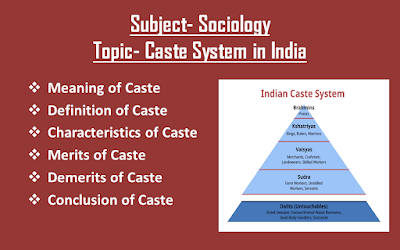Varna System- Meaning and Difference between varna and caste system
# Meaning of Varna System
The Sanskrit word for caste is Varna which means colour. The caste stratification of the Indian Society had its origin in the Chaturvarna system. According to this doctrine the Hindu society was divided into four varnas- Brahmins, Kshatriyas, Vaishyas and Shudra.
The ideology is epitomized in texts like Manusmriti, which describes and ranks four varnas, and prescribes their occupations, requirements and duties or Dharma.
(a) Brahmins: Vedic scholars, priests or teachers.
(b) Kshatriyas: Rulers, administrators or warriors.
(c) Vaishyas: Agriculturalists, farmers or merchants.
(d) Shudras: Artisans, laborers or servants.
The Varna system prevalent during the Vedic period was mainly based on division of labor and occupation. The caste system owns its origin to the Varna system.
In India, communities which belong to one of the four Varnas or classes are called savarna Hindus. The Dalits and tribals which do not belong to any varna were called avarna.
# Difference between Varna and Caste
- In Tabular form
| Varna | Caste |
|---|---|
| Literally 'Varna' Means color and originates from the word 'Vri' meaning the choice of one's occupation. Hence, varna is concerned with one's color or occupation. | Caste or Jati originates from Sanskrit root 'Jaha' meaning 'to be born'. thus, caste is concerned with birth. |
| Varna are only four in number i.e., Brahmins, kshatriyas, vaishyas and shudras. | Castes are very large in numbers. Castes also have sub- castes. |
| Varna is an all- Indian phenomenon. | In caste, there are regional variations mostly based on linguistic difference. |
| Varna system is free from socio- economic and political disabilities as well as restriction. | The caste system imposes many restrictions on the members. |
| Flexible mobility, based on talent and knowledge. | Less mobility, based on birth. |
- In Text form
1. Literally 'Varna' Means color and originates from the word 'Vri' meaning the choice of one's occupation. Hence, varna is concerned with one's color or occupation. On the other hand, caste or Jati originates from Sanskrit root 'Jaha' meaning 'to be born'. thus, caste is concerned with birth.
2. Varna are only four in number i.e., Brahmins, kshatriyas, vaishyas and shudras. While castes are very large in numbers. Castes also have sub- castes.
3. Varna is an all- Indian phenomenon. While in caste, there are regional variations mostly based on linguistic difference.
4. Varna system is free from socio- economic and political disabilities as well as restriction. On the other hand, the caste system imposes many restrictions on the members
5. In varna system, there is flexible mobility and it is based on talent and knowledge. On the other hand, in caste, there is less mobility and it is based on birth.
Watch Video on YouTube





